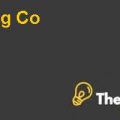Solvency and Capital Structure Analysis:
Solvency is an indicator of long term financial health that is used to measure hospital’s ability to encounter its total debt obligations. Here, three ratios are calculated to measure the Cooley Dickinson Hospital’s solvency which are debt service coverage ratio, cash flow to total debt and equity financing.
Debt Service Coverage Ratio:
Debt service coverage ratio of Cooley Dickinson Hospital is the ratio of total income plus interest expense plus depreciation and amortization expense to interest expense and current portion of long term debt (LTD).
Debt Service Coverage Ratio =
Total Income + Interest Expense + Depreciation and Amortization Expense
Interest Expense + Current Portion of Long Term Debt (LTD)
Debt service coverage ratio of Cooley Dickinson for the year ended 2011 is 4.09 and for the year ended 2012 is 6.67 which is greater than the industry average 4.48 and shows the favorable results with increasing trend form 2011 to 2012. This increase in the ratio shows that the hospital generates sufficient operating income to pay its debt charges and interest payments. An increase in trend shows that the hospital’s operating income is increasing gradually with decreasing rate in debt and interest expenses form its revenues.
Cash Flow to Total Debt:
Cash flow to total debt for Cooley Dickinson is a ratio of total income plus depreciation and amortization expense to total current liabilities and long term debt (LTD).
Cash Flow to Total Debt = Total Income + Depreciation and Amortization Expenses
Current Liabilities and Long Term Debt (LTD)
Cash flow to total debt ratio of Cooley Dickinson for the year ended 2011 is 21.4% and for the year ended 2012 is 29.31% which are greater than the industry average 23.1% and shows the favorable result with an increasing trend form 2011 to 2012. This increase in ratio shows that hospital is generating enough cash from its operating activities to pay its total liability (current plus LTD) as compared to industry average.
Equity Financing:
Equity financing ratio of Cooley Dickinson has been calculated by dividing the total net assets to total assets or total equity to total assets.
Equity Financing = Total Net Assets or Total Equity
Total Assets
Equity financing ratio of Cooley Dickinson at the year ended 2011 is 30.96% and at the year ended 2012 is 33.92% which are lower than the industry average 39.6% and shows an unfavorable increasing trend from 2011 to 2012. Lower ratio form industry average shows that the hospital is highly financed by debt while an increasing trend in ratio shows that capital structure of Cooley Dickinson (high debt and low equity) is shifting towards equity financing by decreasing its current liabilities and long term liabilities. (LTD).
Recommendation:
After doing Cooley Dickinson financial analysis by measuring profitability, liquidity and solvency / capital structuring position of the hospital, it has been found that the company is financially stable as compared to the other community hospitals in the industry.
Apart from the financially sound position of the hospital, some areas still need to be stable in order to get more profit generation and cash flows for the hospital. These areas are collection period of accounts receivable, payment period of accounts payable and equity financing.
For the purpose of reducing the average days in accounts receivable, the hospital should implement some strategies to eliminate the excessive time in billing, invoicing and emailing through postal services which takes much time and several days in process. In order to reduce this process time, the hospital should go for electronic billing and invoicing which reduces such time consumption in accounts receivable collection period that helps to avoid liquidity problems for the hospital.
Apart from it, healthy work relationship and clear credit policies will also help to reduce average days in inventory. Clear credit policies such as discounts, penalties, payment terms and conditions etc. will also be beneficial for the hospital in order to eliminate excessive days from accounts receivable.(Maguire, 2019).
Although long average payment period is beneficial for the hospital but long delay can affect the relationship with creditors. For this purpose, the hospital’s management should call upon a meeting with its creditors and with mutual agreement and set some clear credit policies like discounts within 30 days period, payments methods and terms and conditions etc.These credit policies will help to make long term relationship with creditors that would be beneficial in several ways like huge discounts, good quality and much more. These benefits from supplier’s side can help Cooley Dickinson Hospital Incorporation to get competitive advantage over the competitors.
In order to improve equity to total assets ratio, the hospital should offer some shareholders capital or have an increase in fund raising support program in order to generate and maintain funds for the hospital. These funds increase the total assets as well as total net assets which ultimately leads to an increase in total net assets to total assets ratio.
Appendix 1: Financial Ratios Analysis
| Financial Ratios Analysis | ||||
| 2011 | 2012 | Benchmark | Fav/Unfav | |
| Profitability | ||||
| Operating Margin | 5.61% | 10.06% | 2.20% | Favorable |
| Non-Operating Margin | -0.29% | 0.95% | 0.80% | Unfavorable |
| Total Margin | 5.32% | 11.01% | 3.40% | Favorable |
| Liquidity | ||||
| Current Ratio | 1.72 | 1.54 | 1.51 | Favorable |
| Average Days in Accounts Receivable | 29.14 | 32.95 | 38.00 | Favorable |
| Average Payment Period | 68.53 | 80.55 | 57.00 | Favorable |
| Solvency / Capital Structure | ||||
| Debt Service Coverage Ratio | 4.09 | 6.67 | 4.48 | Favorable |
| Cash Flow to Total Debt | 21.40% | 29.31% | 23.10% | Favorable |
| Equity Financing | 30.96% | 33.92% | 39.60% | Unfavorable |
This is just a sample partical work. Please place the order on the website to get your own originally done case solution.













